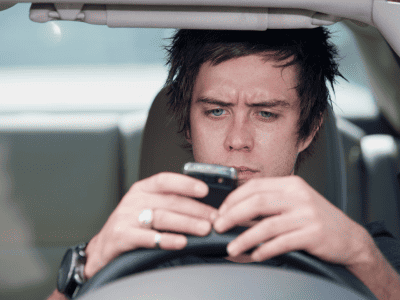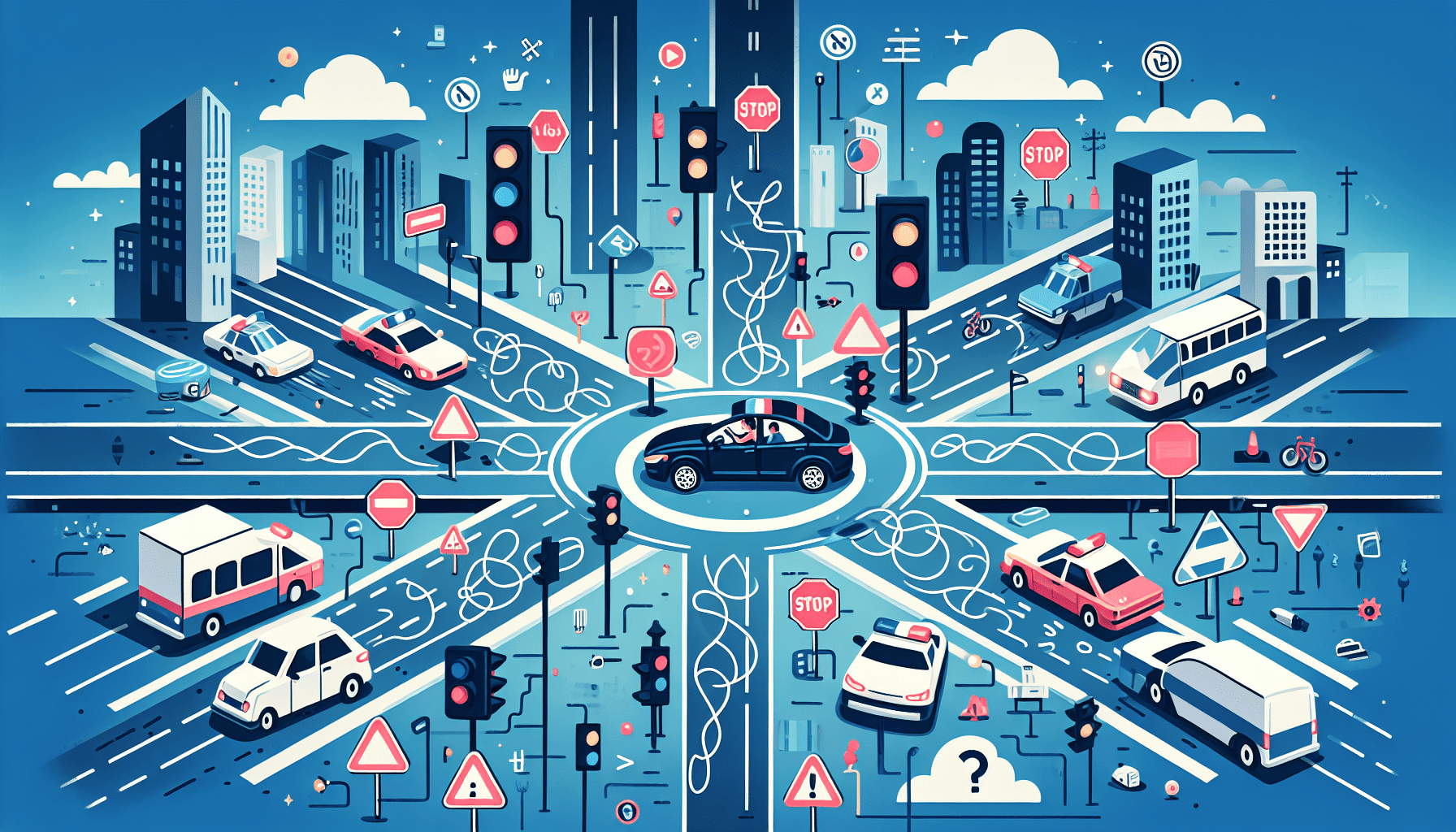Ever wonder how a quick glance at your text messages while driving can hit your wallet through insurance hikes? This article directly addresses the repercussions that distracted driving has on your insurance premiums and coverage, specifically focusing on “how distracted driving can affect insurance.” Without fluff, we delve into the stark figures and policies illustrating how insurance providers respond to instances of distracted driving — from rate surges to coverage adjustments. Read on to comprehend the gravity of a moment’s distraction and safeguard your insurance rates.
Key Takeaways
- Distracted driving significantly increases auto insurance premiums, with an average 49% rate hike after an incident, leading to higher insurance costs for years and potential policy cancellations for repeat offenders.
- Distracted driving encompasses a range of behaviors, including texting while driving, eating, adjusting in-vehicle systems, and more, all of which increase the risk of accidents and contribute to thousands of deaths and injuries annually.
- Legal consequences for distracted driving can vary by state but may include substantial fines, license penalties, and even criminal charges in extreme cases, emphasizing the severity with which the law regards distracted driving.
The Impact of Distracted Driving on Insurance Rates
As more vehicles fill the roads, accidents caused by distracted driving are becoming increasingly common. This has not gone unnoticed by insurance companies, who have seen a rise in claims due to distractions behind the wheel. The result? Higher auto insurance premiums for drivers deemed at risk of causing an accident while distracted.
On average, being involved in a distraction-related incident can lead to a 49% increase in car insurance rates – equivalent to an extra $864 per year for full coverage policies. These heightened rates typically last for three years and could end up costing policyholders over $2,500 in additional expenses. Traffic tickets may also add on penalties.
Insurance providers take incidents of distracted driving seriously as it is perceived as risky behavior that increases their liability when insuring drivers responsible for such accidents. Insurance premium surcharges are determined based on various factors including previous violations and overall assessment of potential risks associated with continued instances of distracting behaviors while operating a vehicle.
Ultimately, one momentary lapse from paying attention on the road can have long-term financial consequences stemming from increased auto insurance costs if found liable through evidence like points against your license or past infractions make you prone to risky behaviors involving misdirected focus on anything beyond simply safe handling control during traveling trips, no matter how briefly unexpected they might be encountered so drive responsibly!
Factors Affecting Rate Increases
A single instance of distracted driving can cause a rise in your insurance premiums, but multiple offenses can result in even higher rates. This is because recurring cases of distracted driving suggest a pattern of risky behavior, indicating to your insurer that you pose an increased risk for causing accidents.
Fortunately, some insurers offer forgiveness programs which lessen the consequences for first-time distracted driving offenses. This does not mean it’s acceptable to engage in distracted driving. Safe and responsible driving should always be prioritized to protect both yourself and other drivers on the road.
State-Specific Penalties and Premium Effects
In the State of Georgia, USA, distracted driving, particularly the use of mobile devices while operating a vehicle, is a significant concern, leading to stringent laws and penalties. The state’s approach to curbing this dangerous behavior is encapsulated in the “Hands-Free Georgia Act,” which came into effect on July 1, 2018. This law prohibits drivers from holding a phone or using any part of their body to support the device while driving. It also bans texting, emailing, browsing the internet, and watching or recording videos when behind the wheel. The penalties for violating these laws are designed to deter distracted driving and underscore the seriousness of the offense.
For first-time offenders, the penalty includes a fine of $50 and one point on their driving record. Subsequent offenses carry heavier penalties; a second offense within 24 months is punishable by a $100 fine and two points on the driver’s license, while a third offense escalates to a $150 fine and three points. These escalating penalties reflect the state’s commitment to reducing distracted driving incidents. Accumulating points can lead to higher insurance premiums and, in severe cases, the suspension of driving privileges. This point system directly impacts drivers’ insurance costs, as insurers often raise premiums for drivers with points on their licenses, considering them higher-risk clients.
Moreover, the impact of these laws extends beyond just penalties. Insurance companies in Georgia are increasingly scrutinizing drivers’ records for distracted driving violations. A history of such offenses can lead to significant increases in insurance premiums. Some insurers may even refuse to renew policies for habitual offenders. This financial repercussion serves as an additional deterrent, encouraging drivers to adhere to safe driving practices. The state’s approach, combining legal penalties with financial consequences through insurance premium adjustments, creates a comprehensive strategy to combat distracted driving and enhance road safety.

Types of Distracted Driving and Their Consequences
Distracted driving is not limited to just texting while operating a vehicle. It encompasses various behaviors that cause drivers to lose focus on the road, including using their phone, being distracted by passengers, failing to drive defensively or engaging in other activities like eating and drinking. These distractions have been linked to numerous crashes involving distracted drivers resulting in auto accidents and fatalities. In 2021 alone, there were 3,522 deaths and 362,415 injuries attributed to distracted driving.
The most common form of distraction for drivers is texting while behind the wheel. It’s not the only one. Other prevalent distractions include applying makeup and adjusting radio/music/GPS systems within the car. Each of these can lead to severe consequences when combined with handling a vehicle on roads shared by others.
This tragic reality highlights how important it is for us all to be more attentive while navigating roads safely.To minimize the risks associated with driver attention lapses, we need to improve our understanding of what causes people to overlook safety concerns when making trips around town.It has never been so crucial, but vital.The alarming figures remind us that urgent action must be taken.
Texting While Driving

Despite being aware of the dangers, about 31% of drivers still admit to texting while driving. This number increases significantly among young drivers aged 16-24 who are considered the worst offenders, with more than 60% engaging in this risky behavior.
The consequences can be catastrophic, as evidenced by statistics showing that in 2021 alone, there were approximately 410 fatalities caused by texting and other cell phone use while driving. Shockingly, a significant portion (17%) of these fatal accidents involved inexperienced drivers under the age of 20. The act of texting behind the wheel increases one’s chance of getting into an accident 23 times compared to drunk driving and 6 times to causing an accident.It also takes approximately five seconds for a driver(texting) to lose awareness about their surroundings, the equivalent of 55miles per hour with close proximity.As such, it is notsurprising that 49 states in the U.S. and Washington, D.C. have enacted laws making texting while driving legal.
Other Common Distractions
While texting while driving is a significant issue, other common distractions can be just as dangerous. Over 50% of drivers admit to eating while driving, a behavior associated with an 80% increase in the chances of being involved in a car accident. Even seemingly harmless activities like drinking coffee or changing the radio station can prove hazardous. The National Highway Traffic Safety Administration reports that 65% of near-miss accidents involve drivers eating or drinking.
Other distractions include adjusting music and using the GPS while driving. These activities negatively impact driving performance and collision avoidance. The bottom line is that any activity that takes your attention from the road, no matter how brief, increases the risk of an accident.

Strategies for Reducing Distracted Driving Risks
Understanding the dangers associated with distracted driving is crucial in order to take steps towards preventing them. There are multiple methods that can be utilized to decrease these risks. For example, creating a routine before getting behind the wheel, such as adjusting seatbelts and mirrors and selecting music, can help minimize distractions once on the road.
Taking precautions like securing children and pets prior to starting the car, as well as utilizing features like ‘Do Not Disturb’ mode on mobile devices are important strategies for managing potential distractions inside vehicles. Making a commitment to abstain from using phones while operating a vehicle has been proven effective in improving focus while driving. In today’s technologically advanced society, there are various tools available that aid in reducing distractions, such as technology that silences calls/messages and tracks one’s driving behavior.
Defensive Driving Techniques

Defensive driving techniques are essential for reducing the risks of distracted driving. A crucial technique is to always keep both hands on the wheel, allowing for quick responses to potential hazards on the road. Another important aspect is minimizing cognitive distractions that can take a driver’s attention away from their surroundings, this particularly applies to inexperienced drivers.
It may seem like using hands-free technology eliminates any risk of distraction while driving, but research has shown otherwise. Even voice-activated texts can cause significant delays in response time, highlighting how easily cognitive distractions can occur even when your hands are still technically “on” the wheel. These findings serve as a reminder of just how vital it is to maintain focus solely on safe and responsible driving at all times.
Utilizing Safe Driving Technology
As technology continues to develop, it also offers solutions for reducing distracted driving. One effective approach is by using hands-free devices while operating smartphones in the car, allowing drivers to keep their eyes on the road and hands on the wheel. Engaging in short conversations that do not demand too much attention can help minimize distractions.
Initiating calls from safe locations is another way to decrease cognitive disruptions caused by setting up a call manually or visually focusing on a cell phone while driving. There are now apps designed specifically for safer use of phones during driving, which track cell phone activity and offer features like “do not disturb” or “driving mode”. These tools aim to manage distractions effectively so that drivers can focus more closely on their task at hand (staying alert behind the wheel) and may even lead to potential discounts with insurance companies.

How Insurance Companies Handle Distracted Driving Claims
When an incident of distracted driving occurs, insurance companies have a structured procedure in place to handle claims. They take into account the seriousness of the accident and the driver’s history with distractions while on the road. In order to assess these claims, insurers carry out thorough investigations by collecting evidence from phone records as well as technology data obtained from within vehicles.
Both auto insurance companies and car insurance companies contribute towards promoting safety on roads by implementing penalties for risky behaviors. There may be variations in how fault is determined during an accident and what consequences it holds for policyholders depending on various factors that come into play.
Determining Fault in Accidents Caused By Distracted Drivers
Determining responsibility in a distracted driving accident is a complex procedure that involves thorough investigation of available evidence, such as potential traffic violations, official reports and statements from involved individuals and witnesses. To create an accurate reconstruction of the incident, insurance adjusters analyze footage from dashboard cameras or surveillance systems while also evaluating the location and extent of vehicle damage.
Cell phone records are carefully reviewed to determine usage timing and locations which can be linked to driver behavior for assigning fault levels. Comparative negligence may be taken into consideration where both drivers could share varying degrees of blame depending on their actions involving cell phones during the event.
In cases where each driver accuses the other solely for causing the accident due to distractions, legal representation by an experienced car accident lawyer may prove necessary in proving liability and claiming rightful compensation.
Policy Cancellations and Non-Renewals
Insurance providers have a responsibility to protect their interests, which can sometimes lead them to cancel or choose not renew policies for individuals with multiple instances of distracted driving. This is done in order to minimize potential risks. If you have a track record of being easily distracted while behind the wheel, insurance companies may view you as a liability and opt not to continue providing coverage.
Insurers are able to monitor your driving behavior through programs that track cell phone usage on the road. This information could impact your policy status and result in higher deductibles or limitations on available coverage options. It is crucial for drivers to maintain safe habits while operating vehicles if they want to avoid any repercussions regarding their insurance protection.

Legal Implications of Distracted Driving Accidents
In addition to financial consequences, distracted driving entails substantial legal liability. To enhance driving behaviors and overall safety on the roads, distracted driving laws have been established to regulate and discourage dangerous practices such as texting while driving. These laws aim to prevent accidents and protect all road users. When distracted driving leads to erratic driving behavior, reckless driving charges can be added on top of fines.
The legal implications of distracted driving are severe and far-reaching. They extend to traffic violations and fines and, in severe cases, can even lead to criminal charges and sentencing.
Traffic Violations and Fines
For those caught driving while distracted, the fine for a first offense is $50. Different US states have their own laws regarding penalties for distracted driving, but they typically start at relatively low amounts such as $20 or go up to a maximum of $1,000.
To monetary fines, repeat offenders may also face additional penalties including mandatory courses on safe driving practices and license suspension. Surcharges may also be added to the fine amount and demerit points could potentially be applied to one’s driver’s license in order to discourage future violations. In more severe cases where there is significant risk posed by distracted driving behaviors, jail time may even be imposed.
The wide variation in fines and escalating consequences for repeated infractions serve not only as deterrents against engaging in distractive activities while behind the wheel, but also demonstrate just how seriously authorities view these actions when it comes to protecting public safety on our roads.
Criminal Charges and Sentencing
Criminal charges can be brought against individuals who engage in distracted driving. If a driver is found to have caused an accident resulting in injury or death due to being distracted, they may face imprisonment and other legal consequences through civil court proceedings. For example, there was a case of a man from Iowa who received 10 years of jail time and was ordered to pay over $300,000 as compensation for fatalities that occurred while he was texting behind the wheel.
Some states have particularly harsh penalties for those caught texting while driving. In Alaska, this offense is considered a class A misdemeanor which could lead to up to one year incarceration and fines of up to $10,000 on their first offense alone. These examples serve as strong reminders about the serious repercussions associated with distracted driving. Emphasizing how important it is always stay focused when operating any vehicle.
Summary
The issue of distracted driving presents a significant danger to both road safety and insurance costs. Insurance rates can see notable increases as a result, influenced by factors like the driver’s history, state regulations, and accident severity. While texting while driving is the most commonly known form of distraction behind the wheel, other activities such as eating or changing music also contribute to higher chances of accidents.
To address this problem effectively, it is crucial to implement strategies such as establishing pre-driving routines, securing passengers (such as children or pets), and utilizing advanced safe-driving technologies. Furthermore, additional information is provided below.
If you’ve been injured in an accident that was the fault of a distracted driver, it’s important to speak with an experienced attorney at Scholle Law. We offer a free consultation where we can discuss your legal options and path to getting the compensation you deserve.
Frequently Asked Questions
What are some consequences of distracted driving?
The potential outcomes of distracted driving can be serious, such as inability to maintain lane position, collisions with pedestrians or cyclists, loss of control over the vehicle and resulting in accidents that may result in fatalities. This not only brings immense pain for families, but also leads to financial struggles.
Will a cell phone ticket affect my insurance in Georgia?
Your insurance rates in Georgia can be impacted by a ticket for using your cell phone while driving, especially if you were the cause of an accident. To avoid any potential consequences on your insurance, it is crucial to consider hands-free options and practice safe driving techniques when using your phone.
It’s important to keep in mind that utilizing hands-free technology and adhering to safe driving habits are key ways to prevent any negative effects on your insurance.
Is distracted driving the main cause of accidents?
The leading cause of accidents is distracted driving, and it accounts for approximately 80% of all accidents. This type of behavior often involves the use of a cell phone while operating a vehicle. The act of being preoccupied or not fully focused on driving can lead to these incidents occurring.
What is the cost of driving distracted?
In 2019, the economic impacts of driving while distracted amounted to a staggering $98.2 billion, making up approximately 29% of all crash costs. This behavior also resulted in tragic consequences including 10,546 deaths and over one million nonfatal injuries.
How does distracted driving affect insurance rates?
Distracted driving can cause a significant increase in insurance premiums, with heightened rates usually lasting for three years and potential surcharges imposed by the insurance company.
It’s essential to avoid distractions while driving to maintain lower insurance rates.

